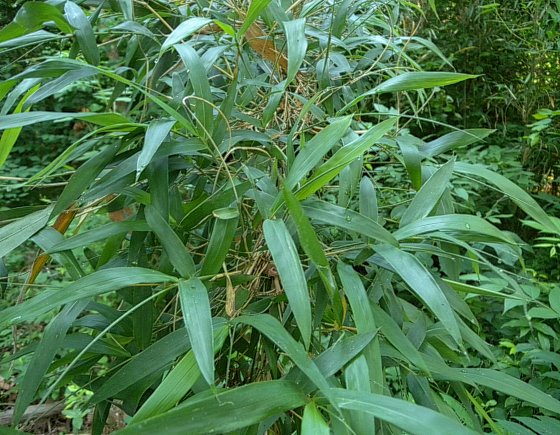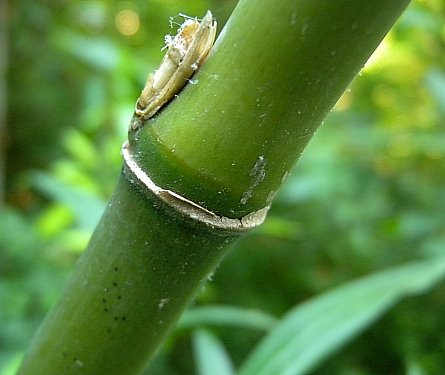
Like other bamboo species, Giant Cane rarely flowers. When this occurs, either racemes or simple panicles of spikelets are produced from the apex of the primary culm and fertile lateral branches. Unlike sterile lateral branches (as described above), fertile lateral branches produce either bladeless sheaths or sheaths with rudimentary blades. Individual spikelets are 1¼-2½" long and 8 mm. (1/3") across, consisting of a pair of glumes at the bottom and 2 overlapping ranks of 6-14 lemmas above. The smaller glume is 2-6 mm. long, while the larger glume is 8-12 mm. long. The lemmas are 15-24 mm. long and keeled along their outer sides, tapering to acute tips or short awns (the latter up to 4 mm. in length). Individual grains are 10-12 mm. long and ellipsoid in shape. The blooming period occurs during the spring or summer. The florets of the spikelets are cross-pollinated by wind. Individual plants bloom only once when they are 10-20 years old, after which they die down. The root system produces long rhizomes, from which clonal colonies of plants are produced. This is the main method of reproduction.
Range & Habitat: Giant Cane is native to southern Illinois, where it is occasional. Illinois lies along the northern range limit of this species. Populations of this grass within the state have declined as a result of development, and large colonies (or canebrakes) have become uncommon. Habitats include bottomland woodlands, flood-prone flatwoods, swamps and edges of swamps, low areas along rivers, bottoms and lower slopes of rocky canyons, and gravelly seeps. While fire will top-kill individual plants of Giant Cane, it is able to regenerate new plants from its extensive rhizomes. Occasional wildfires are beneficial in maintaining populations of this grass if they reduce competition from trees and large shrubs.
Faunal Associations: Some native insects are obligate feeders on Giant Cane and perhaps other Arundinaria spp. These insects feeders include several leafhoppers (Arundanus arundineus, Arundanus flavotinctus, Arundanus marginellus, Arundanus nacreosa, Chlorotettix suturalis) and the caterpillars of such skippers and butterflies as Amblyscirtes aesculapius (Cobweb Roadside Skipper), Amblyscirtes carolina (Carolina Roadside Skipper), Amblyscirtes reversa (Reversed Roadside Skipper), Poanes yehl (Yehl Skipper), Enodia creola (Creole Pearly Eye), and Enodia portlandia (Southern Pearly Eye). A snout moth, Crocidophora pustuliferalis, also feeds on Giant Cane by forming webs around its leaves. Giant Cane also provides cover and it is a source of food for several vertebrate animals. The young culms and leaves are readily consumed by cattle, horses, sheep, deer, beavers, and even black bears because they are high in protein, calcium, phosphorus, and other nutrients. The large seeds of Giant Cane were occasionally eaten by the extinct Passenger Pigeon and Carolina Parakeet. Colonies of Giant Cane (or canebrakes) provide the preferred habitat of the uncommon Canebrake Rattlesnake (a subspecies of the Timber Rattlesnake) and this habitat also attracts Copperhead and Cottonmouth snakes. Canebrakes also provide the preferred nesting habitat of the uncommon Swainson's Warbler and the now extinct Bachman's Warbler. It is thought that the decline of large canebrakes played a role in the extinction of the latter warbler. The Meadow Vole, Golden Mouse, and other small rodents also inhabit this kind of habitat.

Photographic Location: A swampy woodland in Johnson County of southern Illinois.
Comments: Giant Cane is the tallest grass in Illinois, and it is the only bamboo that is native to the state. Amerindians used this woody grass for a variety of purposes, including the construction of buildings, blow guns, mats, and baskets. European settlers used it to make fishing poles, chair bottoms, shuttles, and musical instruments. The large hollow culms and fibrous leaves of older plants have a distinctive appearance that can't be confused with other grasses in the state.